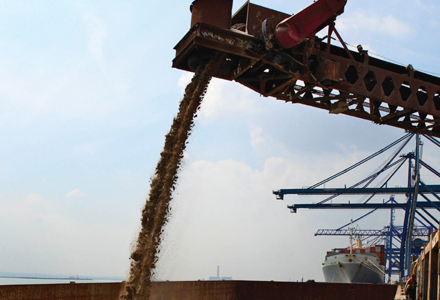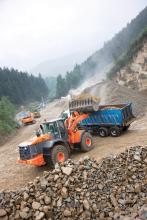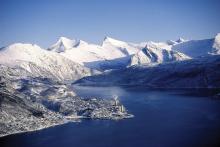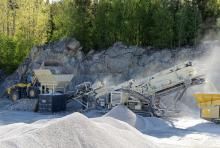
With construction levels at a 20 year low following the global recession, the Danish aggregates business looks set to return to growth
Construction is one of the largest industries in Denmark, with one in four workers in the private sector being employed in it at some level. But in common with countries around the world, business and employment took a sharp tumble from its peak in 2007/2008 and is now at its lowest since the early 1990s..
But cautious optimism seems to be returning to the market, and industry bodies including Danish Aggregate are among those that believe "we have seen the bottom of the crisis for now and that the coming years will show a small growth in the sector," according to chair Kim Fynbo Nielsen
Danish Aggregate, or Danish Mineral Resources, is a new association affiliated to the Danish Construction Association of raw material producers in Denmark. The association brings together suppliers of sand, stone and gravel mined on land and at sea in Denmark. In 2009, members of the association mined a total of 44million tonnes of raw materials - from 400 gravel pits and using 18 ships.
This generated DKK1.7billion (€220million) for the economy.
Unified approach
"The association was founded in order to ensure a more unified industry in future negotiations on raw materials in Denmark," said Nielsen. The plan is to realise its potential of becoming a major association in the construction industry in terms of having greater visibility and a greater impact generally. Membership currently stands at 38 member companies, all of which are big suppliers..
At the launch of the association, director Paul Konrad said, "We also want smaller suppliers." It's the smaller suppliers that drive the need to have a strong trade association, he said, as the supervision of gravel pits is undertaken by the municipalities - which often don't have the experience or the capacity to handle the work.
"We see, among other things, how smaller suppliers do not even get an answer when they need re-approval for the extraction of gravel," he added. "It's also difficult for the smaller companies to be heard in political circles. We hope we can change this with a strong industry association.".
The current membership represents just 10% of the 350 companies that could join over coming months and years. The fact that those 350 operate just 500 quarries indicates the large number of small companies that the associations seeking.
Geologically, the sand and gravel from the outwash plains are excavated all over the country and form the greatest part of Denmark's raw materials output. A very pure quartz sand, without flint or limestone and with less than 1% of heavy minerals, became heavily exploited during the last decade until in 2008 it reached a production figure of 589,000m3.
In 2009 this figure dropped by almost a half, but last year saw a new increase, to read 346,000m3, which still puts it as second only to the core sand, gravel and stones products in terms of output. The main application of this very pure quartz sand is as filter sand and in high quality concrete; it is also used for casting sand and in the construction of sports fields.Significant drop
The total production of raw materials in Denmark has fallen from 41.9million m3 in 2006 to 23.4million in 2010 - a fall of more than 55%. Within that, sand, gravel and stones figures fell too over the same period, but not by as much - from 35.2million m3 to 17.7million m3 - down 50%..
Sand, gravel and stone together form more than 75% of the country's total raw materials output, although this is still a substantial fall from the 84% figure in 2006.
Denmark itself is 19th of the 26 European states producing aggregates, and 2nd of the six that have access to marine products.
With so many companies throughout the country, it's difficult to pinpoint the major players in the industry, but the biggest organisations current among members of Danish Aggregate - which does only represent 10% at the moment - are:
NCC Roads A/S Råstoffer is one of the largest, producing 5million tonnes a year. BG Stone A/S claims to be the largest Denmark-owned gravel producer and has a granite quarry in Norway. Dansand is Denmark's leading specialist in sand, manufacturing 350,000tonnes per year, in more than 20 different gradings - including the fine quartz sand..
KROGH A/S was established in 1935 and has since quarried, processed, sorted and marketed stone, gravel and sand, as well as importing granite from Norway and Sweden. Bedsted Lø Grusværker ApS was founded in 1954 and consists of four gravel pits, which produce 800,000tonnes of gravel every year.
Investment plans
Despite the downturn years, upcoming construction projects throughout the country do hint at a recovery for the industry. These include the Copenhagen Metro City Ring - the fourth phase of the expanding metro network in the Danish capital - and Femern - an immersed tunnel (in earlier design iterations a bridge) that will connect the Danish island of Lolland with the German offshore island of Fehmarn..
Other developments planned for the next several years include major hospitals, major road projects (under the Danish Road Directorate), and major railway projects - all of which will insure at least some solidity to the near future of the aggregates industry.
But there are other elements to the industry's growth that need watching. The key issue, according to Nielsen of Danish Aggregate, is the evaluation of the Mineral Resources Act.
He explained, "The main reason why the law was enforced was because the EU had contacted the Danish government for the repeal of the restrictive rules in mining law. Therefore, the minister of environment was pressed for time to make a revision of the Mineral Resources Act. The law also carries the imprint of that process." And new rules for the 'remuneration of the state' also came into play on 1 January last year. From that date, said Nielsen, "all mining companies must pay DKK8 (€1) in fees to the state per cubic metre of commodities gained at sea in the common areas. Since there is a tax freeze in Denmark the politicians have chosen to call it a fee. And this is in addition to the mining tax in general on all aggregates - DKK5 (€0.7) per cubic metre."
At the same time, permission is only granted for a maximum of five years - including investigation of the area.
"The industry was forced to pay the fee but has maintained that it is too high," explained Nielsen. "For the largest group - fill sand for landfill in ports and coastal feeding - there is a cost increase of more than 25%."
He, the association, and the rest of the industry are waiting to see what happens when the evaluation process of the law starts in the autumn of 2011.







